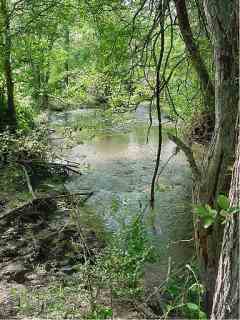
The First Spring: 2001
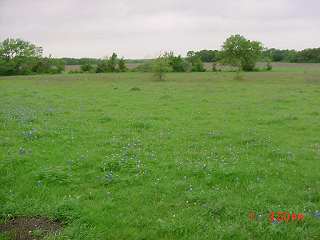
Late March-Early April: view from the gate, northwest past secondary drainage to low knoll and dry woods (on right horizon) and creek woods (on left horizon.) Grass in the foreground--the cool season grasses such as rescue grass and speargrass; bluebonnets are sprinkled across this area. Before the first line of trees, the change in color is the swale (draining right to left). The first line of trees is in the old ditch-diversion; it and the swale meet off the picture left at a bad eroded gulch on the south fenceline. |
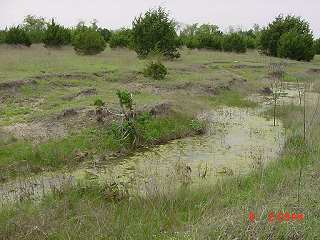
Midpoint of the gully system west of the creek. This linear system suffers creep and slump on both sides, worst on the west bank (across the water from here); the soil holds water, becomes saturated, then fails abruptly. These gullys are steep-sided. Given the amount of soil already lost here, we're considering scooping out the length, piling all that up on the far end, and calling it a stock tank. Ducks would like it. Down in these gullies, when they were dry in the summer of 2000, the Eustoma grandiflorum (Texas bluebells--actually a gentian) were in quantity. |
|
|
|
|
|
|
|
|
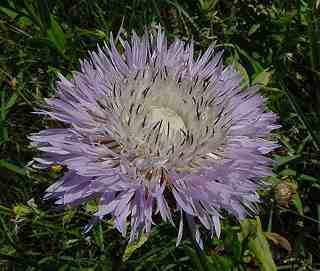
Basketflower is one of our taller wildflowers (4' plus), and filled the "entrance meadow" to the woods this spring. We had a few elsewhere, but most were concentrated in this area, where the understory layer was a mix of black-eyed Susans (Rudbeckias) and gaillardia. Although they look like thistles, they aren't thorny. |
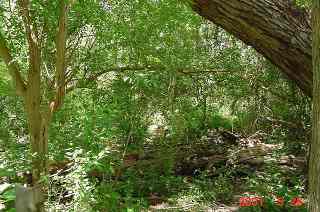
On Memorial Day weekend, while working along the south fenceline near the swamp: this is the kind of tangled mess in the swamp woods. Privet has invaded, along with many native understory plants such as roughleaf dogwood. The heavy limb angling along the top corner is a black willow, part of which has broken off in a storm. The black willows were some of the largest trees in this woods, but suffered severe damage in several ice storms and windstorms. Only a couple of the big ones are left. Just to the right (off picture) is our mystery tree, which keys out to be either a black gum or an eastern persimmon. If it fruits, then we'll know. |

Memorial Day weekend--the swamp at its best. At this point it had not rained for several weeks, and the creek was drying up, but a clear trickle ran out the end of the swamp. Trees near here are black willow, cedar elm, hackberry, sugarberry, roughleaf dogwood, and pecan. |
![]()
 A little later in the spring--woods near the
creek leafing out. The open clearing visible here is the result of large tree loss in a storm
a few years ago. We've planted acorns in there. The nearest trees are cedar elm,
hackberry, and osage orange or bois d'arc. Most of the trees in this area are elms; osage
orange is the next most numerous, followed by hackberries. The ratio differs markedly in different
areas of the woods. The tallest trees (maybe 50 yards away) are over 50' tall.
A little later in the spring--woods near the
creek leafing out. The open clearing visible here is the result of large tree loss in a storm
a few years ago. We've planted acorns in there. The nearest trees are cedar elm,
hackberry, and osage orange or bois d'arc. Most of the trees in this area are elms; osage
orange is the next most numerous, followed by hackberries. The ratio differs markedly in different
areas of the woods. The tallest trees (maybe 50 yards away) are over 50' tall.

